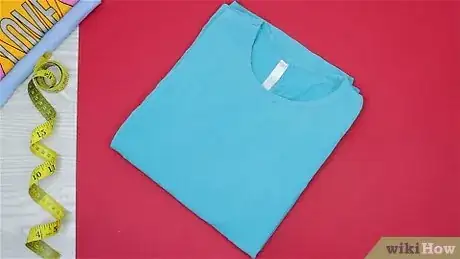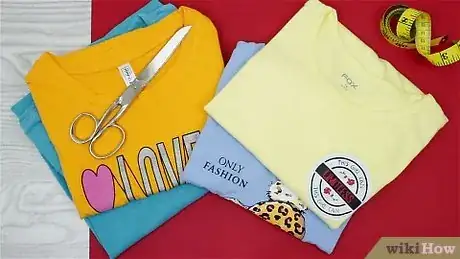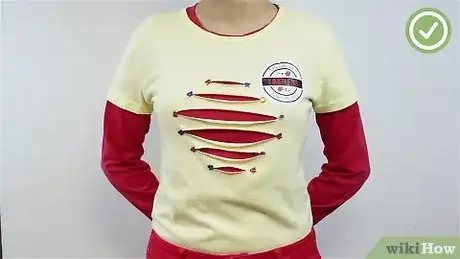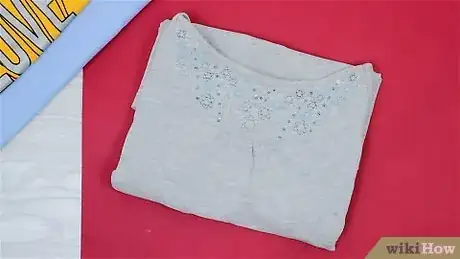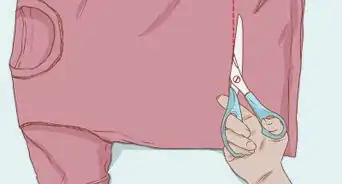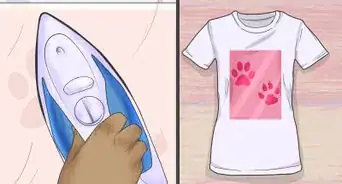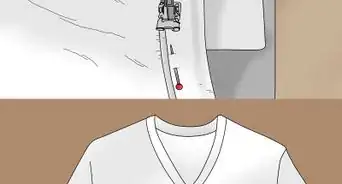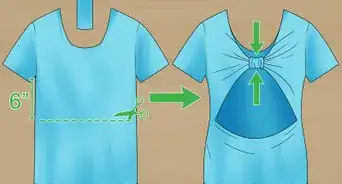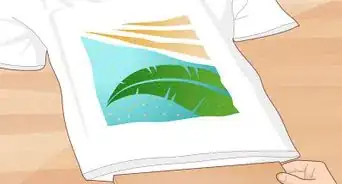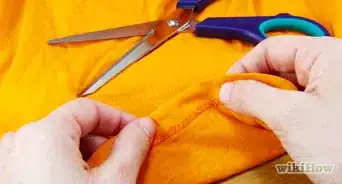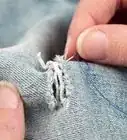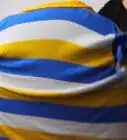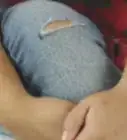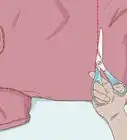wikiHow is a “wiki,” similar to Wikipedia, which means that many of our articles are co-written by multiple authors. To create this article, 11 people, some anonymous, worked to edit and improve it over time.
The wikiHow Video Team also followed the article's instructions and verified that they work.
This article has been viewed 215,623 times.
Learn more...
Distressed clothing can add a hip, "worn-in" vibe to any outfit. However, clothing retailers are known to charge premiums on distressed items. In other words, clothes that have been deliberately damaged may end up costing you more. Why shell out cash for an artificially distressed shirt when it's easy to make your own? See Step 1 below to get started!
Steps
Bleaching Your Shirt
-
1Grab a brightly-colored shirt you'd like to make faded. Bleach, renowned for its ability to ruin colored fabrics by turning them white, is a useful tool for distressing old shirts. In this method, a dilute solution of bleach and water will be used to simulate the dulling, fading effect that years of wear can have on bright-colored clothing. This method is best for strong, bright hues (cherry red, traffic cone orange, and so on), but doesn't work as well on dark shades. For obvious reasons, it's also unsuited for whites.
- As always, only distress shirts that you don't have a special attachment to. You don't want to lose a treasured shirt because you accidentally spilled bleach on it.
-
2Mix water and bleach in a 16-to-1 ratio. Use a suitably-sized container (like a large plastic bucket) as a container for your dilute bleach mixture. Mix well before proceeding. Note that a 16-to-1 ratio is the same as the ratio between gallons and cups, so if you're using a gallon of water, you'd use 1 cup of bleach, 2 gallons (7.6 L) of water would warrant 2 cups of bleach, and so on.
- You may want to consider using a bathtub or a laundry sink to do your bleaching. These are convenient because they allow you to simply wash your mess down the drain when you're done.
Advertisement -
3Add shirt(s) and stir vigorously. It's important to ensure that the shirt (or shirts) you're bleaching receive(s) an even soaking of bleach. Applying more bleach to some areas of the shirt than others can create an uneven, splotchy appearance. To counter this, start stirring as soon as you add your clothing to the bleach bath and stir continuously for about five minutes.
-
4Allow to soak, stirring occasionally. After about the first five minutes, you may begin to stir less frequently. Be sure to monitor your clothing for color loss as it soaks. Stir every few minutes (no less frequently than every five minutes). Most shirts are ready after about half an hour to forty five minutes, but many may be ready earlier.
-
5Rinse and wash. When your clothing has lost as much color as you'd like it to, remove it from the bleach bath and rinse it thoroughly, removing any remaining bleach. Machine wash with warm water and line dry.
-
6Alternatively, for a blotchy look, use a spray bottle of bleach. As noted above, the uneven, splotchy look of a poorly-bleached shirt is generally something most will want to avoid. However, if you're interested in replicating this look, it's quite easy to do so. Mix bleach and water in a spray bottle as above, then bunch up your shirt with rubber bands. Spray the shirt in a few locations with your bleach mixture and allow it to sit for about half an hour, monitoring for color change. When your shirt is how you would like it, remove the rubber bands, then rinse and wash as above.
- Consider adjusting the concentration of your bleach mixture for more or less contrast. For instance, if you use completely undiluted bleach, you'll get splotches of white or near-white against your shirt's natural color.
"Shredding" Your Shirt
-
1Grab a suitable shirt. This method uses long, thin cuts and slices to give your shirt a drastic "destroyed" look. For this method, you'll want a t-shirt that you don't mind ruining. Preferably, the shirt should be solid-colored and bear no screen-printed design (screen prints can be tough and somewhat tricky to make clean cuts through).
-
2Use a pencil to trace your holes. Draw clusters of repeating horizontal or vertical lines of different lengths in an arrangement that looks appealing to you. You can make your shreds anywhere on the shirt that you'd like, so long as they don't make the shirt completely fall apart.
- One easy example is to make a cluster of horizontal cuts on the front of the shirt to produce a makeshift see-through belly shirt. To do this, you would take your pencil and draw level horizontal lines across the front of the shirt in a stylish configuration. For instance, you might start with short lines, then have them gradually grow longer and finally taper off again to make a circular pattern.
-
3Cut along your lines. Use a fabric knife or a sharp pair of scissors to make your cuts. Try to follow your lines as closely as possible. Don't allow the material of the shirt to bunch up in front of your cutting tool - this can lead to jagged, uneven cuts.
- Be careful not to cut too deeply or you may end up making cuts in the bottom layer of your shirt's material. To prevent this, you may want to put a thin piece of cardboard or plastic inside your shirt as a protective barrier.
-
4Consider adding beads or other embellishments. Basic shredded tees look great on their own, but if you'd like to personalize your shirt with additional decorations, feel free! Use any of the following ideas (or your own) to make your shirt uniquely yours:
- Use glue-on decorations (beads, rhinestones, etc.) to give your shirt decorative glitz.
- Draw shapes, designs, cartoons, and more with permanent markers (be careful of ink bleeding - place an insert inside the shirt before drawing).
- If you know how to sew, add a decorative fringe along the bottom of the shirt or sew contrasting patches across the front and back.
-
5Wear your shirt with pride (and an undershirt). Congratulations - your shirt is ready to wear! Don't forget that this shirt exposes your midriff - if you're worried about breaking the dress code at your work or school, be sure to wear an undershirt!
Making Nicks, Holes, and Worn Patches
-
1Use a razor for minor scratches and worn areas. Making major cuts in your shirt is far from the only way to distress it. For instance, with nothing more than a simple disposable razor, its' simple to make small nicks and worn patches in your shirt. Simply drag the razor across the portions you'd like to wear as you would while shaving.
-
2Use scissors for minor holes near the seams. Another way to make your shirt appear naturally worn is to replicate the patterns of wear and tear that are common on actual worn-out shirts. The seams in any piece of clothing are natural points of wear, so tears and cuts in these areas will look especially natural. Fold your shirt along the seam, then use a sharp pair of scissors to make small cuts parallel to the seam. For an authentic look, try making multiple cuts of varying sizes. Below are a few ideas for locations for your cuts:
- Along the seam around the neck hole
- Along the seam at the bottom of the shirt
- Along the seams at the ends of the sleeves
-
3Use a cheese grater for many small holes. To give your shirt a pattern of small rips and holes, use an everyday cheese grater. Stretch the fabric of the shirt as you grate it to ensure the sharp "teeth" of the grater can dig into the fabric of the shirt. You may find this easiest to do if you secure the grater to a sturdy post or pole first, then rub the shirt against it vigorously.
-
4Use sandpaper to wear any screen printing. One of the biggest difficulties when it comes to distressing shirts is that it's tricky to make a shirt's screen printed design look as worn as the rest of the shirt. The ink used for screen printing is relatively thick, tough, and resistant to most distressing methods. To replicate the effects of years of wear and tear on your screen printed shirt, use a square of sandpaper to abrade your screen printed design. For a natural look, wear the design unevenly.
Soaking Your Shirt in a Staining Bath
-
1Grab a light-colored shirt. Essentially the opposite of the bleach method above, this method uses tea and/or a similar staining agent to make a shirt's colors appear darker and muddier, rather than lighter and more faded. As such, this method is best for white or light-colored shirts, though it has some usefulness for vibrant, brightly colored shirts, so long as they're not too darkly shaded.
-
2Mix staining agent(s) in water. Using a large plastic bucket or bathtub to contain your ingredients, mix your staining agents and water to create a staining bath for your shirt. The more dilute your staining bath, the less your shirt will be darkened (and vice versa). There are many possibilities in terms of potential staining agents - see below for just a few:
- Tea
- Coffee
- Dirt
- Paint (earth tones work best for the "naturally worn" look)
-
3Stir and allow to steep. Add your clothing to the staining bath and stir vigorously. Allow your clothes to soak in the liquid, occasionally checking their progress. Depending on the concentration of your staining bath, it can take anywhere from half an hour to several days for your shirt to reach its desired level of darkness, so be sure to remain vigilant as it soaks.
-
4Remove and soak in vinegar and water solution. If you have time, remove your shirt from its staining bath and place it in a bath containing vinegar and water mixed in a 1-to-3 ratio. Soaking the shirt in this dilute vinegar solution helps the stain "set" in the fabric. Allow the shirt to sit for 4 to 12 hours or as needed.
-
5Rinse, wash and dry. Finally, remove the shirt from its bath and rinse thoroughly in the sink, removing any lingering staining agent or vinegar. Machine wash and dry as you normally would.
- Congratulations! Your shirt should be ready to wear.
Community Q&A
-
QuestionWhat kind of material is good for the distressed look?
 Cecilia FloresTop AnswererDenim is best, but you can also do cotton and polyester if you're cutting patterns in it.
Cecilia FloresTop AnswererDenim is best, but you can also do cotton and polyester if you're cutting patterns in it.
Things You'll Need
"Shredding" Your Shirt
- Fabric knife
- Scissors
- T-shirt
- Pencil
- Beads, rhinestones, etc. (optional)
Making Nicks, Holes, and Worn Patches
- Disposable razor
- Scissors
- Cheese grater
- Sandpaper
Bleaching Your Shirt
- Water
- Laundry bleach
- Plastic bucket or bathtub
- Rubber bands (optional)
Soaking Your Shirt in a Staining Bath
- Water
- Tea, coffee, dirt, paint, etc.
- Plastic bucket or bathtub
- Vinegar (optional)
References
About This Article
To make your own distressed shirt, take a disposable razor and drag across the portions of the shirt you’d like to distress. Finish by using a sharp pair of scissors to cut holes along the seams. Alternatively, drag a cheese grater across the shirt to create lots of small holes and rips. Stretch the fabric of the shirt to ensure that the teeth of the grater digs into the fabric. Additionally, if your shirt has a screen printed design, you can try using sandpaper to wear down the ink. For more tips, including how to distress a shirt by soaking it in bleach, read on.
